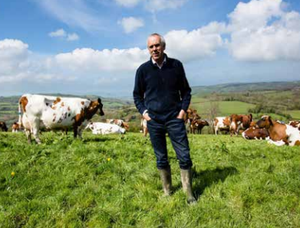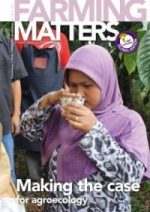Patrick Holden is a farmer and director of the Sustainable Food Trust, an organisation in the United Kingdom providing leadership, influencing research and policy and sharing information on the sustainable transition of food systems. In this article Holden tells his story of True Cost Accounting, an initiative that addresses the invisible costs of so called ‘cheap food’.

The true cost of food has been an issue that has affected me since the beginning of my farming life. Ever since I started farming back in the 1970s, producing milk, wheat and carrots as sustainably as I could manage, but finding it difficult to compete with my neighbours who were using chemical production methods, heavily subsidised through the Common Agricultural Policy. It did occur to us that the root of the problem was connected to the failure of the market to take into account the cost of the damage done by such chemical methods to the environment and public health, evidence of which I recently uncovered when I found a copy of an old article in the Guardian newspaper written in 1984 in my garage. It featured the Sustainable Food Trust board member Peter Segger and I asserting that intensively produced crops reliant on pesticides and fertilizers did not actually produce cheap food at all, despite what the price on the shelf may say.
Impacts from food production
Large scale chemical farmers are not charged for the damage they cause
Food production has multiple impacts both on and off the farm. These can often be negative, such as the pollution of rivers, the emission of greenhouse gases, the spread of antibiotic resistance, the degradation of soil, the rise of obesity and the spread of disease. Yet none of this damage has featured in the balance sheet of farmers using chemical methods (for example, see box). Although these costs are not reflected in the price of food, consumers are paying in other hidden ways, such as through taxes, health care costs, pollution clean up, water rates, as well as deferred costs including emissions causing climate change which will have to be paid for by subsequent generations.
Distorted markets
Patrick Holden, a farmer since the 1970s, set up the Sustainable Food Trust in 2011 and began the campaignfor True Cost Accounting. Back in the 1980s, before a full understanding of the scale of the impact of uncosted damage to the environment and public health became clear, I naively assumed we could solve the problem in the marketplace. Throughout my years at the Soil Association we attempted to tackle this through the development of standards which allowed us to charge premiums for organic food. The intention was to ensure farmers received a fair income for the efforts they made in adopting more sustainable production methods. However, even though the organic market has grown, organic producers still have to compete unfairly with a system that financially benefits the intensive, large scale chemical farmers who are receiving misdirected agricultural subsidies and are not charged for the damage they cause to the environment and public health.More recently, I have come to realise that our economic system is distorted and totally fails to represent the reality of the costs and benefits associated with different methods of food production. But it wasn’t until I set up the Sustainable Food Trust in 2011 that we began to develop the concept of True Cost Accounting.
Towards true cost
This evolving way of thinking seeks to assess the costs and benefits of different food production systems. In doing so, those using production methods that are detrimental to the environment and society would have to pay for the damage they do, while those that are sustainable and deliver a wide range of benefits would be rewarded. This should ultimately have the effect of making food produced in a damaging way expensive, or ideally phased out, whilst sustainable food could become more affordable.
Diversified farms generate more environmental and social benefits than monocultures
Armed with the necessary knowledge and data, governments would be able to introduce policy and economic measures that bring about the change needed. This could involve a mixture of ‘carrots and sticks’ such as taxes on damaging inputs and subsidies for sustainable practices.
In 2013 we held our first events on this theme. First a symposium in Louisville, Kentucky, followed by a two day event in London. This conference included speakers such as Pavan Sukhdev, leader of ‘The Economics of Ecosystems and Biodiversity’ (TEEB), a global initiative focused on the economic benefits of biodiversity, and Professor Jules Pretty, author of key papers that put costs on externalities.
In April 2016 we held another major event spanning three days in San Francisco. The True Cost of American Food conference brought together high level leaders, scientists and influential thinkers in the world of food and farming. Topics covered ranged from a detailed critique of production systems such as CAFOs (concentrated animal feeding operations), to hard hitting issues such as public health, to bigger picture questions such as how can we put a price on the ‘priceless’.
The cost of nitrogen fertilizer
The European Nitrogen Assessment has estimated that collectively, the costs of nitrogen related damage range as high as US$355 billion, or up to US$830 per person every year, about two thirds of which relates directly to agriculture. However, because farmers are not financially accountable for this damage, there is still a good business case for using nitrogen fertilizer – each dollar spent on nitrogen fertilizer brings a three-fold return on the investment for farmers. et, if the harm caused by its use, including CO2 and nitrous oxide emissions, water and soil pollution and its impact on public health were taken into account and nitrogen was taxed in proportion to the damage done, this would in all probability eliminate the financial incentive to use it, as well as improving the financial case for farming systems that avoid the use of chemical nitrogen by using alternative methods for building fertility, such as crop rotations and legumes.
The cost to public health
There is now increasing evidence of direct links between the intensification of our agriculture and food systems and the rapid rise of diseases resulting in unaffordable treatment costs. These include diet-related illness such as obesity, cardiovascular diseases, allergies, some cancers, and diseases of the immune system, many of which are being linked with changes in our farming and food system practices. Obesity alone has a global economic impact of around $2 trillion annually, or 2.8% of global GDP, and it is estimated that in the United States it could be as high $344 billion by 2018, equivalent to 20% of total spending. When these costs are fully understood, they may approach or even eclipse the cost of environmental externalities. An investment in sustainable agriculture, or linking health insurance premiums to improve diets, could reduce these health treatment costs.
Can we measure everything?
As part of this conference we worked with Dr Harpinder Sandhu, of Flinders University South Australia, to develop a sustainability assessment tool that could be applied to individual farms. During the course of his research, Sandhu assessed three US farming operations, including organic dairy farms supplying the Straus Organic Creamery in Petaluma, Joel Salatin’s diversified Polyface farm in Virginia and Jim Erdahl’s corn and soy farm in Minnesota. In each case, Dr Sandhu created his own accounting system of the farm which included all inputs and outputs, not only product sales, but also environmental and social impacts.
Sandhu uses ecological economics to quantify and give a monetary value to environmental and social benefits and costs such as pollution, pollination, soil carbon sequestration, health outcomes and knowledge generation. For example, with his accounting system, Sandhu illustrates the value of knowledge generation on Polyface farm which runs regular farm tours and workshops. Or, for the organic dairy farms, he illustrates the environmental costs associated with animal feed and manure management and for the corn and soy farm there are environmental costs associated with GHG emissions from fertilizer use. In summary, this accounting system illustrates that diversified farms generate more environmental and social benefits than monocultures. Sandhu: “When these benefits are included, farm products [from diversified farms] present better value to society as a whole than the so called cheap beef and milk from feedlot systems, which isn’t really cheap at all.”
Academics like Sandhu approach the complex task of quantifying and putting a price on the costs of producing food in many different ways. In the longer term it would be helpful if they could work towards a common methodology so that comparisons could be drawn more easily. One question is whether it is possible, or even ethical, to value everything. We can only attach surrogate (not actual) costs to animal suffering, species extinction or a breathtaking view, for example. Yet, agricultural policies dictate the food systems we have, and these are set by politicians and largely based on harsh economics. So while we need to recognise the limitations and the potential traps of placing a monetary value on everything, doing so is necessary for the widespread transition to more sustainable food production, processing and consumption.
Challenges

Of course our advocacy of True Cost Accounting has its challenges. Being an issue of immense complexity, spanning the worlds of econom- ics, public health, ecosystems, environment and society, it requires an integrated approach. Unfortu- nately, at least until recently, these different worlds have tended to operate in siloes. For true cost account- ing to work, we must share knowledge and data, and adopt a more systemic way of thinking.
Another major issue is conducting the research and gathering the information. At the moment we have rela- tively little data on the costs of agricultural externalities, and while we are currently drafting a report that will bring together the known research, there remains a huge amount of work to do. Governments urgently need to fund and support research in this area, speci – cally looking at the impact of agriculture on things such as public health and the environment, but crucially, attempting to put monetary values on these impacts.
A political opening
This data is sorely needed as we rework agricultural policy post-Brexit. With potentially quite dramatic subsidy changes looming on the horizon, we must take this as an opportunity to put sustainability at the heart of future policy. There are encouraging signs that a consensus of opinion is emerging and that such an approach will be the best way to improve the economic environment for sustainable food production. As an example Dame Helen Ghosh, chief executive of the National Trust, a conservation organisation in the UK, just made national headlines when she called for a major shift in post-Brexit farm support with all future subsidies needing to be directly connected with tangible, measurable and ultimately monetised public benefits. Even a few years ago, when Dame Helen was permanent secretary at Defra (Department of Environment, Food and Rural Affairs), calling for such a change in the framework of farm support would have been inconceivable.
So, although more than 30 years have passed since Peter Segger and I were calling for such changes in the Guradian article of 1984, at last the external conditions have arisen whereby such actions could become politically possible.
Patrick Holden (patrick@sustainablefoodtrust.org) is a dairy farmer and director of Sustainable Food Trust in the United Kingdom (www.sustainablefoodtrust.org).

